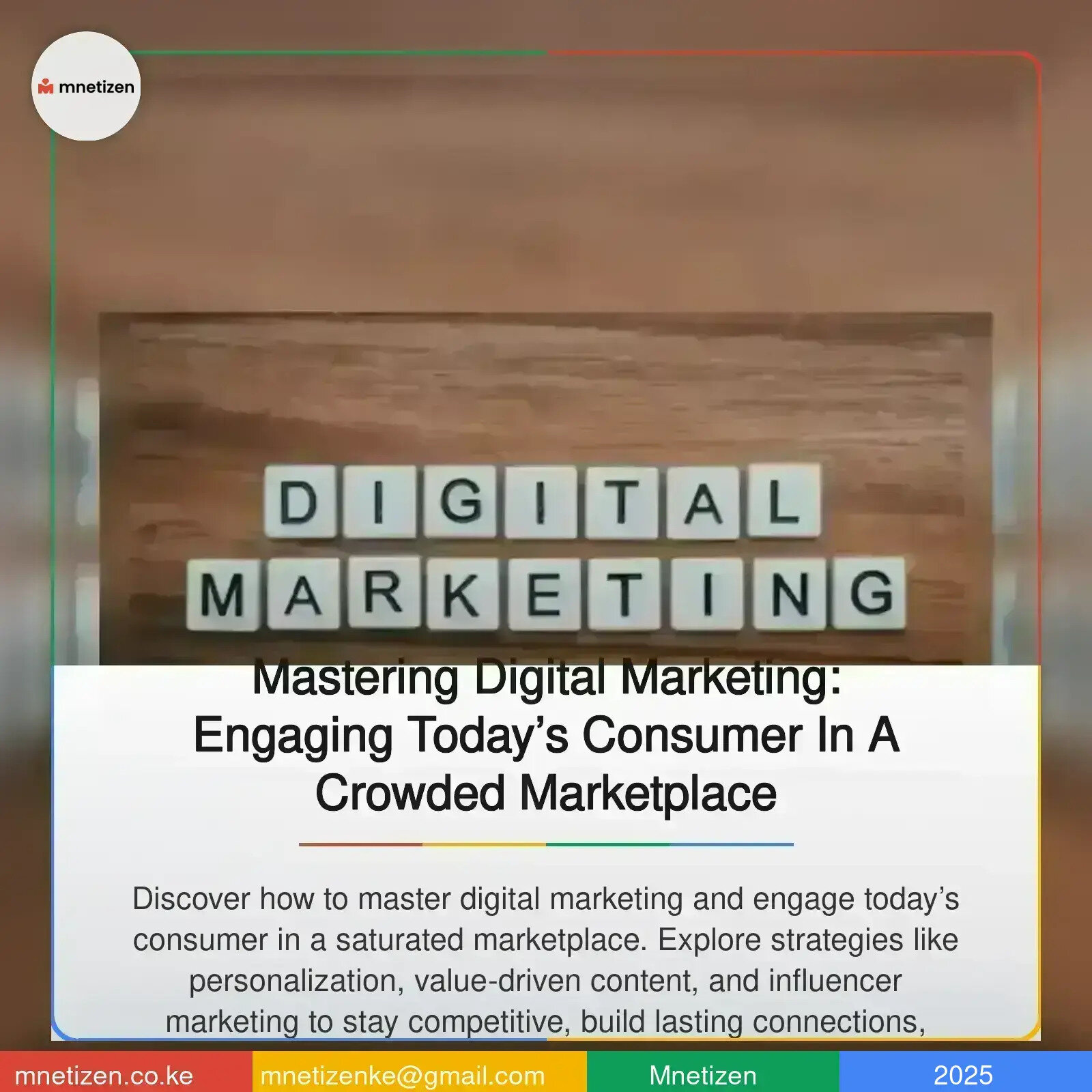Introduction
The overall use of technology for advertisement and marketing communication has gone through a revolutionary process in the last twenty years. This originated from merely placing banners on websites, and has turned into a multi-level warfare with resources for capturing the consumer’s attention on search engines, social networks, emails, and more. Currently, digital marketing is an unavoidable element for brands wanting to engage with modern people who are available online most of the time. The amount of information and advertising messages that customers receive on a daily basis continues to rise which makes it even more challenging for organizations to be noticed. This has created a higher competition that makes firms not only employ digital marketing strategies but great at them. Having this understanding helps brands to keep abreast to changes and fit into the needs of the market as it seeks to continue connecting with the consumer.
But to communicate with today’s consumer, one simply cannot post content on social media and wait for it to be consumed; that takes work. With time and competition in the digital environment increasing, brands face challenges of changing technologies and customer profile. They have to also think creatively while keeping such factors as Artificial intelligence & automation into consideration when trying to enhance the marketing strategies. In this article, we explore the real issues with the idea of dominating the digital marketing landscape in this ruthless world, the actionable tips businesses need so that consumers effectively pay attention to their messages, gain awareness, and ultimately remain loyal.
1. The Shift in Consumer Behavior
New Consumer Behavior has drastically since the ever-growing use of smartphones and the benefit of online convenience shopping. The uses, as the target consumers today are increasingly demanding in terms of immediacy, speed, and convenience in the provision of information, goods and services. These shifts in consumer behavior mean that firms need to be consistently visible in all the touchpoints that their target market engages in. It also implies consumers get shifted from positions characterized by vested interest in the current state of affairs that sustains some firms, to new positions that are reflection of distributed citizenship.
now expect a better, individual and more entertaining experiences are now the core values through which they communicate with brands. It means that such companies leave the consumer preferences unmet at their own risk as the world is becoming more digitalized.
Furthermore, the paths that the given consumer is taking do not follow a single linear format anymore – instead, they are labyrinthine, as the consumer interacts with the marketer at multiple screens of different formats and sizes. Customers can begin by discovering products on social media, then acquire more information regarding the products from a mobile device, and make the purchase through a desktop site. These insights of the complex way in consumers’ journey are vital in the context of brand experiences that endeavour to establish coherent and consistent contacts with consumers at the point-of-need. Reviewing such data from the interactions with customers, companies are being in a position to gain competitiveness within the ever changing digital market place.
2. Building a Strong Digital Marketing Strategy
A good digital marketing strategy starts with business objectives’ statement and knowing your target market. Indiscriminate marketing is not good enough today; brands require data to identify the audience to market to and when to do it. This includes using the SEO technique to make the page to be easily found, using the PPC technique when the need requires instant advertisement and use of social marketing in the site to create interaction. Also, another function of content marketing is allying a brand with leadership to set up the audience for a sell without openly persuading them. Experience tells us that the elements are incorporated into a strategic plan constituting a strong digital strategy to achieve the business goals and meet the customers’ needs.
Notably, data analysis is the engine of the digital marketing effort. However, it allows business organizations to track campaign performance within real-time, meaning that if there is something wrong, then the business organization can easily shift direction. Metric analysis implies daily or monthly monitoring of the Web-site traffic, CTR, and other conversion rates, which allow cause he wants to make right decisions to maximize his marketing activities always. Also, the integration of artificial intelligence and machine learning make it possible for marketer to foresee trends, categorize audiences, and tailor the content of the marketing messages appropriately. Finally, all the digital marketing can be summed up as a creative bargain based approach to turn data into insights and adapt to the changes.
3 . Personalization and Consumer Engagement
The market today is filled with countless stimuli, so individualization has become the key to successful communication with a consumer. Today’s consumers demand that brands create content, make offers and send messages that are relevant to the recipient in particular. Marketing messages that are based on demographics and general consumer trends are now obsolete—thanks to personalization, a company can engage the consumer in an emotional manner, which will enhance the likelihood of a sale and make the consumer more loyal to the brand. Some of the ways brands are capable of developing these levels of client experience include dynamic email marketing, product suggestions that are tailored, and retargeting advertisements depending on the clients’ browsing history. There is nothing as disheartening as receiving a message from a complete stranger which you did not invite in the first instance but when it is an invited message then you will not mind even if the message is sent by a stranger.
What is the great approach of personalization? Through the accumulation of consumers’ qualitative and quantitative data, including the interaction on brands’ social media accounts, previous purchase behavior and online consumer behavior, brands can understand consumers’ needs, frustrations and buying patterns. This makes it possible for marketers to design communications that are well understood and hence evoking higher response rates and sales. However, it is equally important to note that personal marketing is not limited to comprehension of clients through internet social networking, but it can also include physical contact too. The standpoint of synching online and offline customer data to offer an end-to-end customer journey that strives to meet the needs of the consumer will be the way in which more organisations tackle customer engagement in the future.
4 . Content is King: Creating Value-Driven Content
Information is still the key media for digital marketing, as customers always look for something interesting and helpful to them via the internet. Consequently, brands need to be selecting and generating the kind of content that not only stands out but it also offers real value to customers and stakeholders. This is because you have to be churning out quality blog posts, infographics, videos, and interactive content that addresses some consumer pain point and provides solution. That is why, valuable and credible posts contribute to the achievement of the primary goal – making a brand a recognizable authority in its niche. Companies that try to educate their clients through content creation are likely to appeal to consumers who consider such brands their primary source of information.
Indeed, apart from generating enticing content, the same deserves to be shared across different channels. Nobody uses any social platform the same way- what applies to Instagram may not apply to LinkedIn. Hence, a good content marketing policy also weighs on content format and communication media most appropriate to address the target public. In addition, search engines tends to rank websites that regularly update their content as relevant and this acts a as a bonus to content creation since it attracts consumers and increases visibility in the same ratio. Finally, the content that educates and entertains as well as creates calls to action builds consumers and brands’ presence in the digital environment.
5. Social Media Influence and Influencer Advertising
What used to be an effective way of connecting with people has developed into one of the strongest marketing tools in today’s world. Currently, there is a populace of over two billion users of social media, using the platforms of Facebook, Instagram, Twitter, Tiktok among others, implying that brands have a direct shot at a global market. But mere establishment of the brand presence here is not sufficient; they have to produce content, conversations that appeal to the users, and promote community. Social media makes it possible for brands to create friendly, relevant images that reflect im previously unimagined ways the brands’ values and engage consumers on the fly. Through Facebook, Twitter, or any other social networking sites or by sharing photos or videos that its customers post online, through promotions, or through webcast, business can create and establish meaningful interaction with customers thus promoting brand association.
Besides using organic social media promotion strategies, influencer marketing has become an effective weapon for brand that intends to familiarize itself to the market. The modern customer is also more likely to believe something advertised through a blogger or anyone they follow than hearing a generic ad. Brands need to engage mega-influencers in a different way from micro-influencers because these megas have different audiences and can increase credibility. The essence of IML is trusting the author: choosing the influencer who shares the values of a business and is close to the target client base will increase their conversion. This combination of using social media and influencer marketing makes them both forces to be reckoned with when it comes to boosting the image of a brand online.
Conclusion
Digital marketing is advancing each day hence the need for one to always be on the lookout for these new trends. Nonetheless, branding that is effective is one that willingly adapts, whether that means integrating AI for its marketing and sales, trying out new formats of content, and platforms. Digital marketing one cannot master it in one go it is all about learning and experimenting over and over and tweaking. Companies that focus on relationship marketing, special value, relevant content, and data approach will manage better on today’s customer within growing market.
The future of digital marketing does not lay in inundating the consumers with more and more advertisement messages. When content creates an experience tailored to the individual, complied with truthfulness and relevance, it enables a brand and its followers to cut through the clutter. In a scenario where consumers’ time is precious, only those brands which can impress the consumers, at every point of contact and remain in their mind will be successful.


























